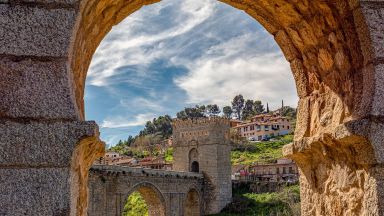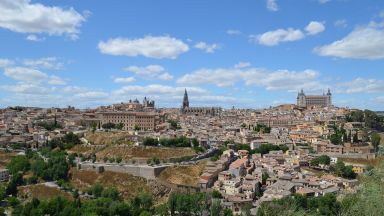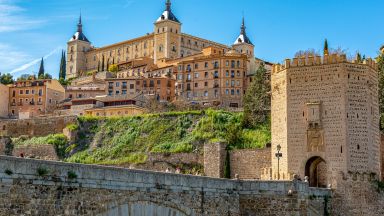Synagogue of Santa Maria la Blanca
Church, Historic Building and Synagogue in Toledo
The Synagogue of Santa María la Blanca, also known as the Ibn Shoshan Synagogue, is a museum and former synagogue situated in Toledo, Spain. Its construction is dated to the late twelfth or early thirteenth century, and some believe it to be the oldest standing synagogue in Europe, although this claim is disputed and requires citation.
Located in the former Jewish quarter of Toledo, the synagogue lies between the Monastery of San Juan de los Reyes and the Synagogue of El Transito. Alongside two other preserved synagogues, it was built by Jews in a Mudéjar or Moorish style during the reign of the Christian Kingdom of Castile. Notably, in the early 15th century, the building was transformed into a Catholic church.
History of the Synagogue of Santa Maria la Blanca
The precise origins and original specifications of the Synagogue of Santa María la Blanca pose challenges in dating. Evidence indicates that it was likely constructed in the late twelfth or early thirteenth century CE. The architectural style closely resembles Almohad monuments from the twelfth century, such as the Tinmal Mosque and Kutubiyya Mosque.
One widely accepted belief is that the synagogue was built around 1205, supported by historical documents mentioning a “new” grand synagogue in Toledo. Additionally, a wooden tablet found in the area mentions raising ruins in the year 4940 (CE 1180). This inscription raises the possibility that the synagogue could have been a reconstruction of a pre-existing building or a new construction on the same plot.
Some hypotheses suggest that the layout might have been inspired by a pre-existing mosque on the site, while a similar layout found in a former synagogue in Segovia indicates the existence of more synagogues of this type in the region. However, despite ongoing investigations, the exact origin and nature of the Synagogue of Santa María la Blanca continue to be intriguing historical mysteries.
Certain historians, like Leopoldo Torres Balbás, have observed similarities between the plaster work in the aisles of Santa María la Blanca and the later-dated convent Las Huelgas de Burgos, which was constructed around 1275. However, Carol Herselle Krinsky argues that the ornamentation’s scale, proportion, and placement, along with the use of light in the space, align more closely with twelfth-century mosques, suggesting an earlier construction date for the synagogue.
The original patron of the synagogue remains somewhat uncertain, but there is evidence pointing to Joseph ben Meir ben Shoshan, also known as Yusef Abenxuxen. Joseph was the son of a finance minister to King Alfonso VIII of Castile, and his epitaph mentions his involvement in building a synagogue upon his death in 1205. Some theories propose that Joseph may have reconstructed the synagogue following a pogrom against Jews in Toledo, possibly accounting for its irregular floor plan and suggesting a late-twelfth-century construction date.
The historical investigation into the origins and patrons of the Synagogue of Santa María la Blanca continues, adding to the intriguing mysteries surrounding this remarkable building’s past.
Conversion of Santa Maria la Blanca to a church
Following the pogroms of 1391 and the anti-Jewish preaching by Vicente Ferrer, the Synagogue of Santa María la Blanca suffered looting and was eventually seized by the Catholic church. It was formally consecrated as a church in the early 15th century, with varying sources suggesting different years: 1401, 1405, 1410, or 1411. The church was later entrusted to the Order of Calatrava.
During this period, the name “Santa Maria la Blanca” was adopted, derived from an effigy of Mary that was housed within the building. Subsequently, three small apses in Renaissance style were added between 1550 and 1556, serving as chapels and still visible today, credited to Alonso de Covarrubias.
Over the years, the building served various purposes, including as a military barracks, a warehouse, and a dancehall. However, in 1856, it was designated a national memorial site and underwent restoration. Subsequently, the archdiocese regained ownership through a local parish in 1929. Today, the Synagogue of Santa María la Blanca stands as a museum and popular tourist attraction, preserving its rich and multifaceted historical significance.
The Synagogue of Santa Maria la Blanca appears in our Complete Guide to Visiting Toledo!
This website uses affiliate links which may earn a commission at no additional cost to you!
Visiting Synagogue of Santa Maria la Blanca
1 March – 15 October 10:00 – 18:45 *
16 October – 28 February 10:00 – 17:45 *
Adults €4,00, Children €3,00
Nearby Attractions
- Baños del Ángel (0.1) km
Baths in Toledo - Casa del Judío, Toledo (0.1) km
Historic Building in Toledo - Monasterio San Juan de Los Reyes (0.1) km
Monastery in Toledo - Synagogue of El Transito (0.2) km
Museum and Synagogue in Toledo - Iglesia de Santo Tomé (0.2) km
Church in Toledo - Museo del Greco (0.2) km
Gallery and Museum in Toledo - Puerta Del Cambrón (0.3) km
City Gate in Toledo - Puente de San Martín (Toledo) (0.3) km
Bridge in Toledo - Iglesia de El Salvador, Toledo (0.3) km
Church in Toledo - Convento de Santo Domingo El Antiguo (0.3) km
Monastery and Museum in Toledo



